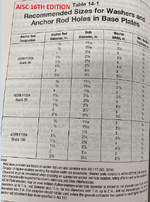olr
Civil/Environmental
- Mar 25, 2021
- 10
please help me understand AISC specs for anchor rod hole diameters in base plates
table 14-1 in AISC 16th edition (recommended sizes for washers and anchor rod holes in base plates) specs the maximum hole diameters as long as special washers are used, like square washers or round washers that meet the acceptable width in the same table.
if I want to use non-special washers (like ASTM F844 washers), Table 14-1 has a note at the bottom stating if F844 washers are used, the hole diameters are limited to
D + 5/16 (for D <= 1")
D + 1/2 (for 1" < D <= 2")
D + 1 (for 2" < D)
i've been taught to assumed contractors will use common F884 washers, so I follow the hole spec from the note. during QC I often get comments saying that hole sizes can just be D + 1/4" in all cases form one engineer, another engineer says just do D + 1/2" in all cases.
Does the note below table 14-1 also spec max hole sizes for F884 and engineers can spec anything less than that? for example 1/4" oversize is a more convenient spec than 5/16" oversize for D<= 1"
What is the correct way to size hole diameters for F844 washers?

table 14-1 in AISC 16th edition (recommended sizes for washers and anchor rod holes in base plates) specs the maximum hole diameters as long as special washers are used, like square washers or round washers that meet the acceptable width in the same table.
if I want to use non-special washers (like ASTM F844 washers), Table 14-1 has a note at the bottom stating if F844 washers are used, the hole diameters are limited to
D + 5/16 (for D <= 1")
D + 1/2 (for 1" < D <= 2")
D + 1 (for 2" < D)
i've been taught to assumed contractors will use common F884 washers, so I follow the hole spec from the note. during QC I often get comments saying that hole sizes can just be D + 1/4" in all cases form one engineer, another engineer says just do D + 1/2" in all cases.
Does the note below table 14-1 also spec max hole sizes for F884 and engineers can spec anything less than that? for example 1/4" oversize is a more convenient spec than 5/16" oversize for D<= 1"
What is the correct way to size hole diameters for F844 washers?


